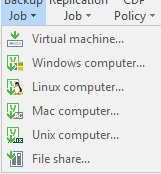If I’m creating a Windows backup, for a particular drive on a file server….is it best to create a File Share backup or a Volume level backup (essentially both backup the same set of files). ie which is most efficient or recommended as a best practice?
File Share vs Volume
Best answer by MicoolPaul
Then I’d just go down the agent route here, my justifications being:
Community is limited to 10x instances. An instance can be 1 server or 500GB NAS data, you said you’ve got 5 servers ranging from 750-1500GB, so you could end up over on community licenses now or in the future with NAS backup vs agent will be a fixed 5 server = 5 instances.
Agent backup processing will consume CPU/RAM on the file server when it’s backing up, but it’s daily so this could be shifted out of hours if you have resource contention.
You don’t need to create a file proxy for agent-based backups
You’re nowhere near the Microsoft VSS size limit (64TB) that would necessitate an alternative architecture.
Theres other questions I’d explore if this was a project I was working on, but it’s quite safe to say this will work well for you without needing to complicate things!
Enter your E-mail address. We'll send you an e-mail with instructions to reset your password.



